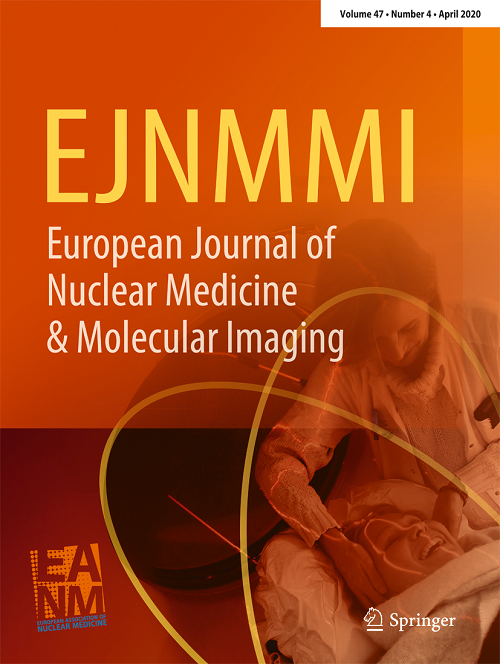PSMA PET/CT时代原发性转移性前列腺癌发病率增加:一项基于人群的分析
IF 8.6
1区 医学
Q1 RADIOLOGY, NUCLEAR MEDICINE & MEDICAL IMAGING
European Journal of Nuclear Medicine and Molecular Imaging
Pub Date : 2025-07-08
DOI:10.1007/s00259-025-07431-8
引用次数: 0
摘要
目的探讨前列腺特异性膜抗原(PSMA) PET/CT用于原发性分期对全国前列腺癌(PCa)发病率及治疗方式的影响。方法:在这项基于人群的队列研究中,从2010年到2023年,所有在荷兰被诊断为PCa的男性都在荷兰癌症登记处被确认。诊断年份被用作PSMA PET/CT可用性和用于初级分期的替代指标。计算总体和分期欧洲年龄标准化发病率(ESR)和估计年百分比变化(EAPC)。在具有≥1个高危特征的患者中,进行logistic回归来评估诊断年份与盆腔淋巴结和/或远处转移的检测之间的关系。进行探索性分析以评估治疗的变化。结果2010 - 2023年PCa的ESR略有下降(EAPC=-0.2%, p = 0.64)。同时,仅盆腔淋巴结阳性和远处转移性PCa的ESR升高(EAPC分别为4.6% [p < 0.001]和4.1% [p < 0.001])。与PSMA PET/CT初级分期有限的时期相比,具有≥1个高危特征的患者在增加(or = 1.33)和广泛(or = 1.65)的年份更常被诊断为盆腔淋巴结和/或远处转移。同时,接受全身治疗的患者比例从38.7%上升到42.0% (OR = 1.15)。结论PSMA PET/CT在临床实践中的应用,似乎与向盆腔淋巴结阳性和远处转移性前列腺癌的重大分期转移有关。探索性分析还表明,更频繁的治疗与缓和,而不是治愈的意图。需要进一步的研究来评估对临床结果的影响。本文章由计算机程序翻译,如有差异,请以英文原文为准。
Increased incidence of primary metastatic prostate cancer in the era of PSMA PET/CT: a population-based analysis.
PURPOSE
To evaluate the effects of prostate-specific membrane antigen (PSMA) PET/CT use for primary staging on nationwide stage-specific prostate cancer (PCa) incidence rates and treatment patterns.
METHODS
For this population-based cohort study, all men diagnosed with PCa in the Netherlands from 2010 to 2023 were identified in the Netherlands Cancer Registry. Year of diagnosis was used as proxy measure for PSMA PET/CT availability and use for primary staging. Overall and stage-specific European age-standardized incidence rates (ESR) and estimated annual percentages change (EAPC) were calculated. Among patients with ≥ 1 high-risk feature, logistic regression was performed to assess the association between year of diagnosis and detection of pelvic lymph node and/or distant metastases. Exploratory analyses were conducted to assess changes in treatment.
RESULTS
From 2010 to 2023, the ESR of PCa declined slightly (EAPC=-0.2%, p = 0.64). Meanwhile, the ESR of pelvic node-positive only and distant metastatic PCa increased (EAPC = 4.6% [p < 0.001] and 4.1% [p < 0.001]). Patients with ≥ 1 high-risk feature were more often diagnosed with pelvic lymph node and/or distant metastases in the years with increasing (OR = 1.33) and widespread (OR = 1.65) access compared to the period with limited access to PSMA PET/CT for primary staging. Meanwhile, the proportion of patients that received systemic therapy increased from 38.7 to 42.0% (OR = 1.15).
CONCLUSION
The implementation of PSMA PET/CT in clinical practice, appears to be associated with a substantial stage shift towards pelvic node-positive and distant metastatic PCa. Exploratory analyses also suggest more frequent treatment with palliative, rather than curative intent. Further research is needed to evaluate effects on clinical outcomes.
求助全文
通过发布文献求助,成功后即可免费获取论文全文。
去求助
来源期刊
CiteScore
15.60
自引率
9.90%
发文量
392
审稿时长
3 months
期刊介绍:
The European Journal of Nuclear Medicine and Molecular Imaging serves as a platform for the exchange of clinical and scientific information within nuclear medicine and related professions. It welcomes international submissions from professionals involved in the functional, metabolic, and molecular investigation of diseases. The journal's coverage spans physics, dosimetry, radiation biology, radiochemistry, and pharmacy, providing high-quality peer review by experts in the field. Known for highly cited and downloaded articles, it ensures global visibility for research work and is part of the EJNMMI journal family.

 求助内容:
求助内容: 应助结果提醒方式:
应助结果提醒方式:


